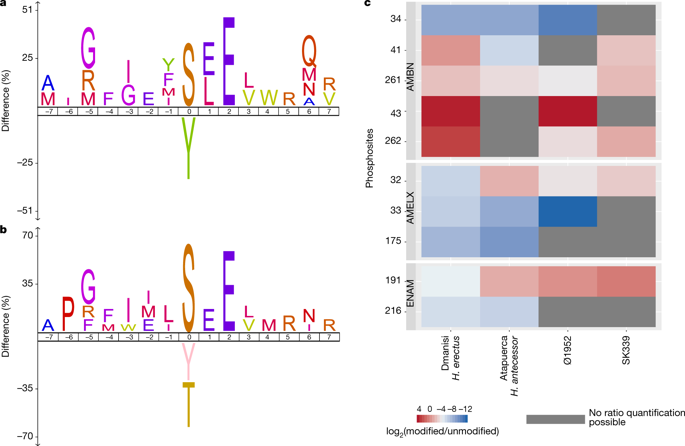Nature ( IF 50.5 ) Pub Date : 2020-04-01 , DOI: 10.1038/s41586-020-2153-8 Frido Welker 1 , Jazmín Ramos-Madrigal 1 , Petra Gutenbrunner 2 , Meaghan Mackie 1, 3 , Shivani Tiwary 2 , Rosa Rakownikow Jersie-Christensen 3 , Cristina Chiva 4, 5 , Marc R Dickinson 6 , Martin Kuhlwilm 7 , Marc de Manuel 7 , Pere Gelabert 7 , María Martinón-Torres 8, 9 , Ann Margvelashvili 10 , Juan Luis Arsuaga 11, 12 , Eudald Carbonell 13, 14 , Tomas Marques-Bonet 4, 7, 15, 16 , Kirsty Penkman 6 , Eduard Sabidó 4, 5 , Jürgen Cox 2 , Jesper V Olsen 3 , David Lordkipanidze 10, 17 , Fernando Racimo 18 , Carles Lalueza-Fox 7 , José María Bermúdez de Castro 8, 9 , Eske Willerslev 18, 19, 20, 21 , Enrico Cappellini 1

|
The phylogenetic relationships between hominins of the Early Pleistocene epoch in Eurasia, such as Homo antecessor, and hominins that appear later in the fossil record during the Middle Pleistocene epoch, such as Homo sapiens, are highly debated1,2,3,4,5. For the oldest remains, the molecular study of these relationships is hindered by the degradation of ancient DNA. However, recent research has demonstrated that the analysis of ancient proteins can address this challenge6,7,8. Here we present the dental enamel proteomes of H. antecessor from Atapuerca (Spain)9,10 and Homo erectus from Dmanisi (Georgia)1, two key fossil assemblages that have a central role in models of Pleistocene hominin morphology, dispersal and divergence. We provide evidence that H. antecessor is a close sister lineage to subsequent Middle and Late Pleistocene hominins, including modern humans, Neanderthals and Denisovans. This placement implies that the modern-like face of H. antecessor—that is, similar to that of modern humans—may have a considerably deep ancestry in the genus Homo, and that the cranial morphology of Neanderthals represents a derived form. By recovering AMELY-specific peptide sequences, we also conclude that the H. antecessor molar fragment from Atapuerca that we analysed belonged to a male individual. Finally, these H. antecessor and H. erectus fossils preserve evidence of enamel proteome phosphorylation and proteolytic digestion that occurred in vivo during tooth formation. Our results provide important insights into the evolutionary relationships between H. antecessor and other hominin groups, and pave the way for future studies using enamel proteomes to investigate hominin biology across the existence of the genus Homo.
中文翻译:

人类祖先的牙齿蛋白质组
欧亚大陆早更新世的古人类(例如前人)与中更新世时期化石记录中后期出现的古人类(例如智人)之间的系统发育关系备受争议1,2,3,4,5 . 对于最古老的遗骸,这些关系的分子研究受到古代 DNA 降解的阻碍。然而,最近的研究表明,对古代蛋白质的分析可以解决这一挑战6,7,8。在这里,我们展示了来自 Atapuerca(西班牙)9,10的H. antecessor和来自 Dmanisi(格鲁吉亚)1的直立人的牙釉质蛋白质组,两个关键的化石组合,在更新世古人类形态、扩散和分化模型中发挥着核心作用。我们提供的证据表明,H. antecessor是随后的中更新世古人类(包括现代人类、尼安德特人和丹尼索瓦人)的近亲姐妹谱系。这种布局意味着现代般的脸H.先行者,也就是说,类似于现代的人,可能在属相当深的祖先智人,而尼安德特人的颅骨形态代表派生形式。通过恢复 AMELY 特异性肽序列,我们还得出结论,我们分析的来自 Atapuerca的H. antecessor摩尔片段属于男性个体。最后,这些H. 前身和直立人化石保留了牙齿形成过程中体内发生的牙釉质蛋白质组磷酸化和蛋白水解消化的证据。我们的研究结果为H. antecessor和其他古人类群体之间的进化关系提供了重要的见解,并为未来使用牙釉质蛋白质组研究人类存在的古人类生物学铺平了道路。











































 京公网安备 11010802027423号
京公网安备 11010802027423号